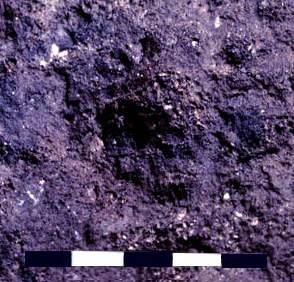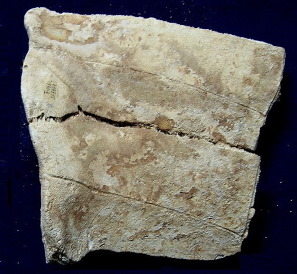Stratum 4: Shaley Red
Composed of thin slabs of limestone up to 12 inches across, this stratum seems to have been built up by the decaying process of the back wall, and follows its contour. The limestone slabs are coated with a thin covering of red clay which is varied in thickness and cemented in some parts.
This stratum had several features at its lowest levels and a variety of animal bones and chipped-stone artifacts, none of which are diagnostic. Two chipped stone scrapers, a utilized flake, and a quartzite cobble were found in close proximity to the features. The carapace of a large turtle was found in this area as well.
Feature 37-6 was a possible hearth, based on charcoal stains and burned-looking earth that suggested a fire had been built directly on the ground. Joint fragments of a large animal (bison?) were nearby, and these appeared slightly burned.
Next to the hearth was an enigmatic feature discovered when two flat, thin slabs of limestone, common in this stratum, were turned over, exposing a few small animal bones. Further digging revealed a concentration of thousands of small animal bones (see examples below). In the center was an area about one-inch in diameter in which the bones and soil were black. Several inches deeper into the next level, a second concentration of bones was uncovered. Almost all of these were blackened, although the soil did not appear burned, nor was there ash present. The entire fill from both features was bagged and removed for washing through a nested fine screen.
It was not clear whether the soil in these bone-filled deposits was burned or merely stained by wet organic matter, such as wood. In his field notes, Redder speculates the two features may represent the droppings from an owl or other predator bird roosting in the shelter. Small animals such as lizards, mice, shrew, vole, bird, and fish may have been eaten, then their bones regurgitated and dropped in pellets.
Another possibility is that the bone concentrations are the remains of several meals consumed by human occupants. At the Berger Bluff site in south Texas, archeologist Ken Brown encountered a similarly varied array of microvertebrates in a dense deposit on a Late Pleistocene bench. Concentrated near a hearth, a circular area of fire-baked and ashy sediment, the tiny bones may represent the latrine for the site's occupants. Coprolite (fecal) remains from sites such as Hinds Cave in the Lower Pecos Canyonlands seem to indicate that prehistoric people often consumed small animals whole—bones, scales, and all. At Horn Shelter, however, the presence of such difficult-to-swallow items such as catfish spines would make this scenario less likely. Interestingly, Berger Bluff also contained remains of extinct turtle in the bench deposit.
Although there were neither diagnostic artifacts nor radiocarbon assays for this layer, its stratigraphic position and the presence of bones of extinct creatures indicate it is Late Pleistocene in age.

|

|






